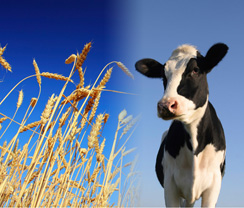
Animal / Plant
Cases
Technical Information
Contact Us
 By comparing the genome sequences at the individual or population level, genomic variations can be analyzed. Molecular breeding based on resequencing includes a variety of applications, such as functional gene or marker detection, functional characterization of genes, and new varieties development. To date, we have successfully completed the Silkworm, Maize, and Soybean Projects, and have gained much experience from many other on-going plant and animal resequencing projects.
By comparing the genome sequences at the individual or population level, genomic variations can be analyzed. Molecular breeding based on resequencing includes a variety of applications, such as functional gene or marker detection, functional characterization of genes, and new varieties development. To date, we have successfully completed the Silkworm, Maize, and Soybean Projects, and have gained much experience from many other on-going plant and animal resequencing projects.
Benefits:
- Deep experience in high throughput whole genome sequencing
- Rapid turnaround and competitive cost
- Advanced bioinformatics analysis with reliable results
- Customized analysis available
Genome-wide Patterns of Genetic Variation Among Elite Maize Inbred Lines. Nature Genetics 2010.42, 1027-1030.

Generated a whole genome map of single nucleotide polymorphisms, insertion/deletion variation and the gene content variation among elite maize lines in China. The results provide a variable source for genetic studies, quantitative trait loci identification and molecular breeding of this important crop. It also provides additional clues to the molecular basis of heterosis.
Resequencing of 31 Wild and Cultivated Soybean Genomes Identifies Patterns of Genetic Diversity and Selection. Nature Genetics 2010. 42, 1053-1059.

Provided important information to facilitate soybean breeding program. The soybean genome resequencing project generated a huge amount of genomics data to expedite future soybean research, such as population studies, marker-assisted breeding application, and gene function identification.
Bioinformatics:
Data filtering (removing adaptors contamination and low-quality reads from raw reads)
- Alignment
- Statistics of data production
- Assembly of consensus sequences
- SNP calling, annotation and statistics
- InDel detection, annotation and statistics
- Structure variation detection, annotation and statistics
Advanced Analysis:
- Population Genetics Analysis
- Linkage Analysis
- HapMap Construction & GWAS
- Point Mutation Localization
- Alien Chromosome Segments Localization
Sample Requirements:
For the genomic DNA samples you will provide:
- Purity:OD260/280=1.8-2.0, without degradation and RNA contamination.
- Concentration: ≥30 ng/μl
- DNA amount: library preparation starts from at least 10μg, the more the better.

